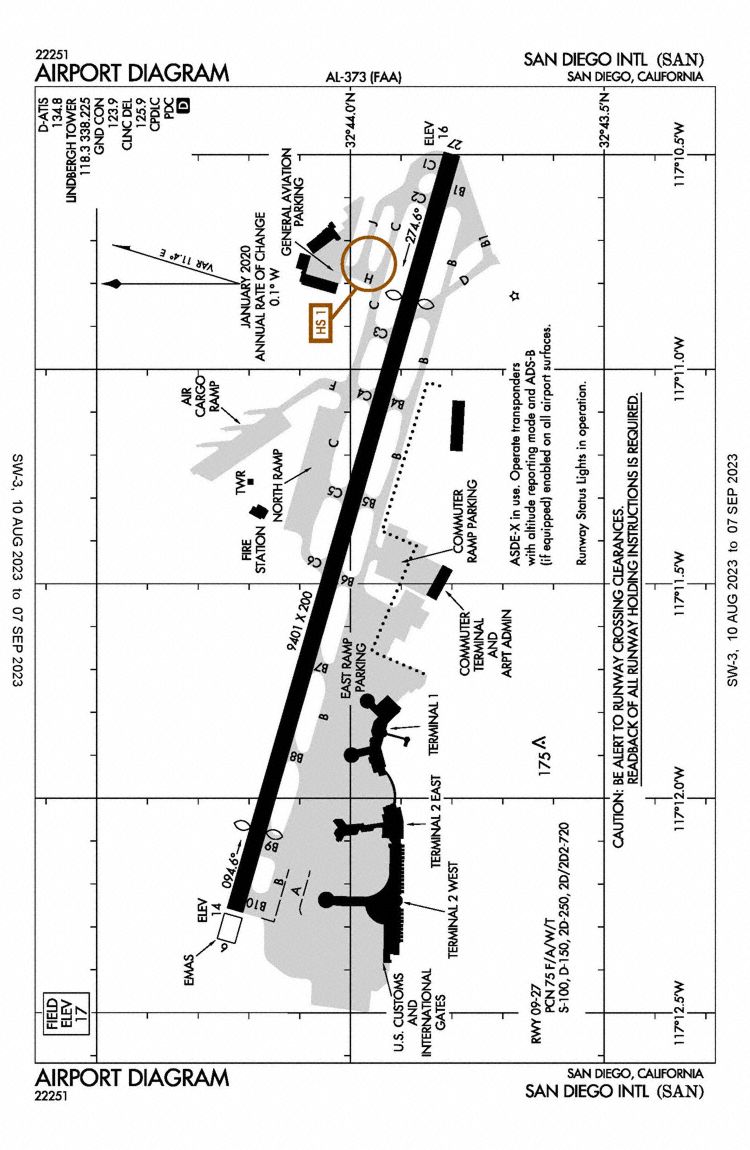A Southwest Airlines Boeing 737-700, registration N7734H performing flight WN-2493 from San Diego,CA to San Jose,CA (USA), was at holding point B1 and was instructed to line up runway 27 at 12:03L (19:03Z) and wait with the advice that landing traffic was 5nm out. The aircraft went onto the runway and stopped about 470 meters/1550 feet ahead of the displaced runway threshold.
About 50 seconds prior to the instruction to line up and wait to WN-2493 Tower cleared a Citation to land on runway 27, traffic would be holding in position.
About 2:10 minutes after the 737 had been instructed to line up runway 27 and wait the crew of the landing Citation queried, whether they were still cleared to land, in return tower instructed the Citation to go around, then instructed the 737 to vacate the runway via the next taxiway to the right, taxiway C2. The 737 queried for the reasoning, tower responded, there was traffic 2nm out behind them. The 737 crew complied and vacated the runway and subsequently went to holding point C1.
The Citation positioned for another approach and landed safely about 14 minutes later.
The 737 departed about 10 minutes after the go around of the Citation.
ADS-B data suggest that the Citation was already over the runway about 150 meters/480 feet ahead of the displaced runway threshold having overflown the 737 at low height when it reached the lowest height of about 100 feet AGL starting to climb again.
The FAA opened an investigation into the occurrence and stated: "The controller had previously cleared the Citation to land on Runway 27 and then instructed Southwest Flight 2493 to taxi onto that runway and wait for instructions to depart. The facilitys automated surface surveillance system alerted the controller about the developing situation."
The NTSB announced: "NTSB investigating Aug. 11 runway incursion and overflight at San Diego Intl Airport that occurred when a Cessna 560X was cleared to land on Runway 27 and conflicted with a Southwest Airlines Boeing 737 which was in a line up & wait on Runway 27. No injuries or damage reported."
On Sep 30th 2025 the NTSB released their final report concluding the probable causes of the incident were:
The local control controllers poor judgment in duty prioritization which distracted them from monitoring arriving and departing traffic and resulted in a runway incursion and loss of same runway separation. Contributing was the operations supervisors decision to troubleshoot a faulty flight strip printer instead of maintaining direct supervision of the operation.
The NTSB analysed:
SAN was equipped with the Airport Surface Detection Equipment Model-X (ASDE-X) surface radar system. The system was operational and functioned as designed. It produced both aural and visual alerts that indicated that there was an aircraft [N564HV] landing with another aircraft [SWA2493] still in position on the same runway. The local control (LC) controller immediately reacted to the ASDE-X alerts, and issued instructions to resolve the conflict, but not before standard separation had been lost.
The SAN Airport Traffic Control Tower (SAN ATCT) facility was equipped with two flight strip printers, one functioned as a primary device, and the second as a backup in case the first unit failed. In post incident interviews, the SAN ATCT personnel stated that they received no training on the use or troubleshooting of these printers. Prior to the incident, the primary printer jammed. During the postincident interview with the operations supervisor (OS), they stated that they chose to troubleshoot the primary printer rather than switching to the backup, and that this drew their attention away from the operation at the time of the incident. FAA Order JO 7110.65BB, Air Traffic Control, 2-10-3, Tower Team Position Responsibilities, states in part:
a. Tower Team Concept and Intent: There are no absolute divisions of responsibilities regarding position operations. The tasks to be completed remain the same whether one, two, or three people are working positions within a facility/sector. The team, as a whole, has responsibility for the safe and efficient operation of that facility/sector.
The LC controller noticed a flight strip at their workstation that indicated an initial altitude for an uninvolved departing aircraft that was not in accordance with facility directives and contacted Southern California Terminal Radar Approach Control (SCT TRACON) to coordinate an appropriate altitude. This diverted their attention from N564HV and SWA2493 momentarily. During the post-incident interview conducted with the LC controller, they stated that they had used poor judgment in prioritizing their duties. This duty prioritization was not consistent with guidance contained in FAA Order JO 7110.65BB, Air Traffic Control, 2-1-1, ATC Service.
Metars:
KSAN 112051Z 27009KT 10SM BKN013 23/18 A3001 RMK AO2 SLP161 T02330183 58005=
KSAN 111951Z 27007KT 240V310 10SM BKN013 BKN018 23/18 A3001 RMK AO2 SLP163 T02330183=
KSAN 111851Z 25007KT 230V290 10SM BKN011 BKN018 BKN250 22/18 A3002 RMK AO2 SLP166 T02170183=
KSAN 111751Z 22008KT 10SM BKN013 OVC018 22/19 A3002 RMK AO2 SLP166 T02220189 10222 20211 51005=
KSAN 111700Z 22007KT 10SM BKN013 OVC018 22/18 A3003 RMK AO2 T02170183=
KSAN 111651Z 26004KT 10SM OVC016 22/18 A3002 RMK AO2 SLP166 CIG 014V018 T02170183=
KSAN 111625Z 27006KT 10SM OVC016 22/18 A3002 RMK AO2 T02170183=
KSAN 111551Z 27005KT 10SM OVC014 22/18 A3002 RMK AO2 SLP164 T02170183=
Aerodrome Chart San Diego (Graphics: FAA):

About 50 seconds prior to the instruction to line up and wait to WN-2493 Tower cleared a Citation to land on runway 27, traffic would be holding in position.
About 2:10 minutes after the 737 had been instructed to line up runway 27 and wait the crew of the landing Citation queried, whether they were still cleared to land, in return tower instructed the Citation to go around, then instructed the 737 to vacate the runway via the next taxiway to the right, taxiway C2. The 737 queried for the reasoning, tower responded, there was traffic 2nm out behind them. The 737 crew complied and vacated the runway and subsequently went to holding point C1.
The Citation positioned for another approach and landed safely about 14 minutes later.
The 737 departed about 10 minutes after the go around of the Citation.
ADS-B data suggest that the Citation was already over the runway about 150 meters/480 feet ahead of the displaced runway threshold having overflown the 737 at low height when it reached the lowest height of about 100 feet AGL starting to climb again.
The FAA opened an investigation into the occurrence and stated: "The controller had previously cleared the Citation to land on Runway 27 and then instructed Southwest Flight 2493 to taxi onto that runway and wait for instructions to depart. The facilitys automated surface surveillance system alerted the controller about the developing situation."
The NTSB announced: "NTSB investigating Aug. 11 runway incursion and overflight at San Diego Intl Airport that occurred when a Cessna 560X was cleared to land on Runway 27 and conflicted with a Southwest Airlines Boeing 737 which was in a line up & wait on Runway 27. No injuries or damage reported."
On Sep 30th 2025 the NTSB released their final report concluding the probable causes of the incident were:
The local control controllers poor judgment in duty prioritization which distracted them from monitoring arriving and departing traffic and resulted in a runway incursion and loss of same runway separation. Contributing was the operations supervisors decision to troubleshoot a faulty flight strip printer instead of maintaining direct supervision of the operation.
The NTSB analysed:
SAN was equipped with the Airport Surface Detection Equipment Model-X (ASDE-X) surface radar system. The system was operational and functioned as designed. It produced both aural and visual alerts that indicated that there was an aircraft [N564HV] landing with another aircraft [SWA2493] still in position on the same runway. The local control (LC) controller immediately reacted to the ASDE-X alerts, and issued instructions to resolve the conflict, but not before standard separation had been lost.
The SAN Airport Traffic Control Tower (SAN ATCT) facility was equipped with two flight strip printers, one functioned as a primary device, and the second as a backup in case the first unit failed. In post incident interviews, the SAN ATCT personnel stated that they received no training on the use or troubleshooting of these printers. Prior to the incident, the primary printer jammed. During the postincident interview with the operations supervisor (OS), they stated that they chose to troubleshoot the primary printer rather than switching to the backup, and that this drew their attention away from the operation at the time of the incident. FAA Order JO 7110.65BB, Air Traffic Control, 2-10-3, Tower Team Position Responsibilities, states in part:
a. Tower Team Concept and Intent: There are no absolute divisions of responsibilities regarding position operations. The tasks to be completed remain the same whether one, two, or three people are working positions within a facility/sector. The team, as a whole, has responsibility for the safe and efficient operation of that facility/sector.
The LC controller noticed a flight strip at their workstation that indicated an initial altitude for an uninvolved departing aircraft that was not in accordance with facility directives and contacted Southern California Terminal Radar Approach Control (SCT TRACON) to coordinate an appropriate altitude. This diverted their attention from N564HV and SWA2493 momentarily. During the post-incident interview conducted with the LC controller, they stated that they had used poor judgment in prioritizing their duties. This duty prioritization was not consistent with guidance contained in FAA Order JO 7110.65BB, Air Traffic Control, 2-1-1, ATC Service.
Metars:
KSAN 112051Z 27009KT 10SM BKN013 23/18 A3001 RMK AO2 SLP161 T02330183 58005=
KSAN 111951Z 27007KT 240V310 10SM BKN013 BKN018 23/18 A3001 RMK AO2 SLP163 T02330183=
KSAN 111851Z 25007KT 230V290 10SM BKN011 BKN018 BKN250 22/18 A3002 RMK AO2 SLP166 T02170183=
KSAN 111751Z 22008KT 10SM BKN013 OVC018 22/19 A3002 RMK AO2 SLP166 T02220189 10222 20211 51005=
KSAN 111700Z 22007KT 10SM BKN013 OVC018 22/18 A3003 RMK AO2 T02170183=
KSAN 111651Z 26004KT 10SM OVC016 22/18 A3002 RMK AO2 SLP166 CIG 014V018 T02170183=
KSAN 111625Z 27006KT 10SM OVC016 22/18 A3002 RMK AO2 T02170183=
KSAN 111551Z 27005KT 10SM OVC014 22/18 A3002 RMK AO2 SLP164 T02170183=
Aerodrome Chart San Diego (Graphics: FAA):

This article is published under license. Article Source
Published Date















